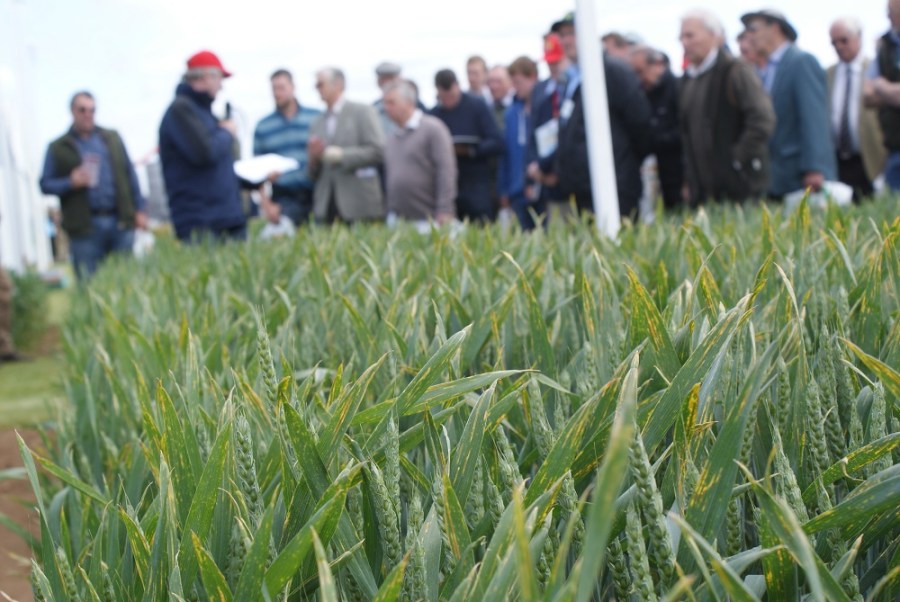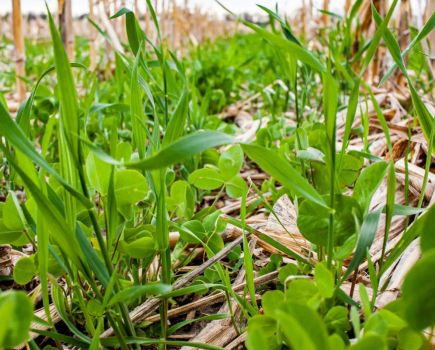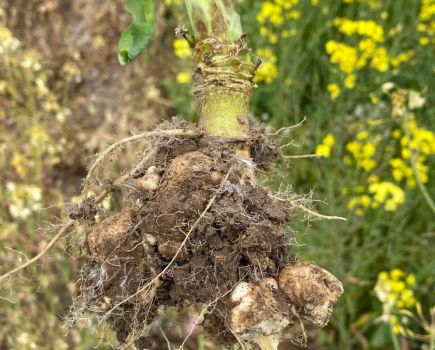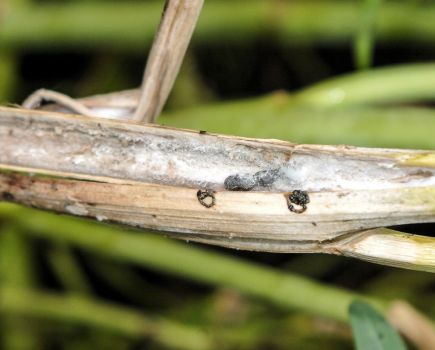Behind the scenes, there’s been a subtle change supporting the criteria used to create the AHDB Cereals and Oilseeds Recommended List. CPM finds out why and how this benefits growers.
We want varieties with good disease resistance to come through
By Lucy de la Pasture
Yield has always been king when it comes to assessing candidates for that invaluable almanac, the AHDB Cereals and Oilseeds Recommended List (RL). To some extent that still holds true, but the RL wheat crop committee, led by AHDB’s Dr Simon Oxley, has recently introduced a sense check to the selection process to make sure new varieties with valuable agronomic attributes aren’t slipping through the net.
Plant breeding has become one of the biggest assets to growers in the fight against disease and, against a backdrop of reduced azole efficacy and the discovery of SDHI insensitivity within the septoria population, the introduction of new varieties with strong agronomic traits is set to become even more important. Encouraging breeders to introduce varieties with better resilience is crucial for the future, explains Simon Oxley.
“Under the previous selection criteria, varieties that weren’t topping the yield tables, but may have had a relatively high untreated yield, wouldn’t always have been selected. For wheat breeders, there’s often a trade-off between breeding for disease resistance and yield. So breeding for agronomic traits wasn’t always a primary objective, yet we want varieties with good disease resistance to come through,” he explains.
Relative risk
To help the RL crop committee achieve this objective, the concept of relative risk was born and was used as a supporting tool to the selection process for the first time in 2015. Looking at relative risk is effectively a way of making sure that any new varieties that offer relatively lower risk to grow, meaning they have a good agronomic merit score and a high untreated yield, aren’t missed off the RL, explains Simon Oxley.
“We wanted to make selection fairer and relative risk helps the RL committee put multiple factors together so we don’t lose potentially good varieties. It gives breeders the opportunity to select for good agronomic traits and still have a chance of making it onto the RL,” he adds.
“Relative risk takes into account the disease resistance and straw strength of varieties, which are individually weighted according to the importance of the agronomic trait. For example, the RL Septoria tritici resistance score is weighted by a factor of 4 to reflect the very high importance of the disease, yellow rust by a factor of 2 and straw strength by a factor of 3, to give an indication of a variety’s agronomic merit,” he explains.
“The agronomic merit is then plotted against untreated yield and this graph can be divided into quadrants to indicate the relative risk of growing one compared with other varieties. The relative risk may be high, low or neutral.”
Varieties that are lurking in the neutral squares in the relative risk quadrant may not be as unexciting as they appear at first sight, believes Simon Oxley. “They may be weak for disease but have high untreated yields which indicates that the variety may still perform even when under disease pressure. These genetic traits for tolerance to a disease would be worth further investigation,” he says. It means relative risk is a useful tool for highlighting such potential and ensuring ‘the baby doesn’t get thrown out with the bathwater’.
The introduction of the tool in assessing candidates for the RL has been welcomed by plant breeders, he continues. As well as encouraging more candidate varieties with good agronomic traits, the balancing of the emphasis on yield will help breeders produce wheat varieties that arable farmers will need in the future, he believes.
But as well as trying to future proof wheat breeding programmes, relative risk information offers an immediate benefit to growers. It’s not information that’s currently published within the RL, but making it available in some form is something that AHDB is working hard on and hopes to make available to growers in time for this season’s variety decisions.
“We have plans to incorporate the data into the Variety Selection Tool in the future, so that relative risk information is then available on the AHDB website, but we also want to develop more tools in the future to help growers,” explains Simon Oxley.
Headline varieties
But as things stand, relative risk is something that can help growers interpret the data presented on the RL.
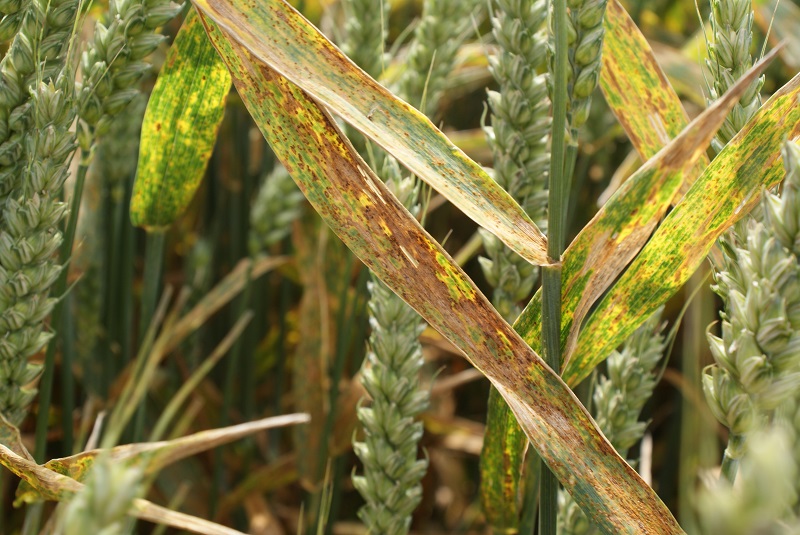
The RL Septoria tritici resistance score is weighted by a factor of 4 while yellow rust gets a weighting factor of 2.
“Headline varieties on the RL that grab most attention are the ones that offer an improvement in yield potential, but it may be that a variety further across the RL may well be better suited to a grower’s own conditions and looking at relative risk may help highlight these,” he says.
What is important to understand is that relative risk isn’t the same as absolute risk, it’s a way of comparing varieties to one another. In the past, varieties with better agronomics may have been considered lower input and perhaps one to shut the gate on. A practical consideration is that varietal management isn’t that simple even at low relative risk, points out Simon Oxley.
“The initial assumption by growers was that management would be the same when the concept was introduced to them at Monitor Farm and agronomy meetings earlier in the season. In fact, low relative risk varieties need to be managed differently and may be more challenging to manage because monitoring is so important.”
The data used to produce relative risk is by its nature historic, but with diseases like yellow rust evolving in the blink of an eye and a potential for SDHI resistance to evolve to Septoria tritici, things can change rapidly in season, as many growers have experienced with yellow rust this spring in varieties like Reflection.
“If you have a variety with a better rust resistance then there’s the opportunity to make a potential saving on fungicides, but no guarantee. A close eye needs to be kept on crops and changes made to the fungicide approach within the season if the disease situation alters in the field,” he advises.
For growers in the North and West of the country, where septoria tends to be the biggest disease threat, the opportunity to fine-tune fungicide sprays can be challenging, particularly when spray days are limited.
“This is where relative risk can aid growers in selecting a spread of varieties that’ll give more flexibility in the timing of fungicide application. If a variety has a low relative risk because it has good septoria resistance, then it can be a second priority because the implications of a fungicide being applied a couple of days later than ideal won’t be as great as for some other varieties,” notes Simon Oxley.
Another benefit of a relative risk approach during variety selection is that it removes a degree of uncertainty about new varieties, which means growers can adopt newcomers with more confidence provided they monitor them closely.
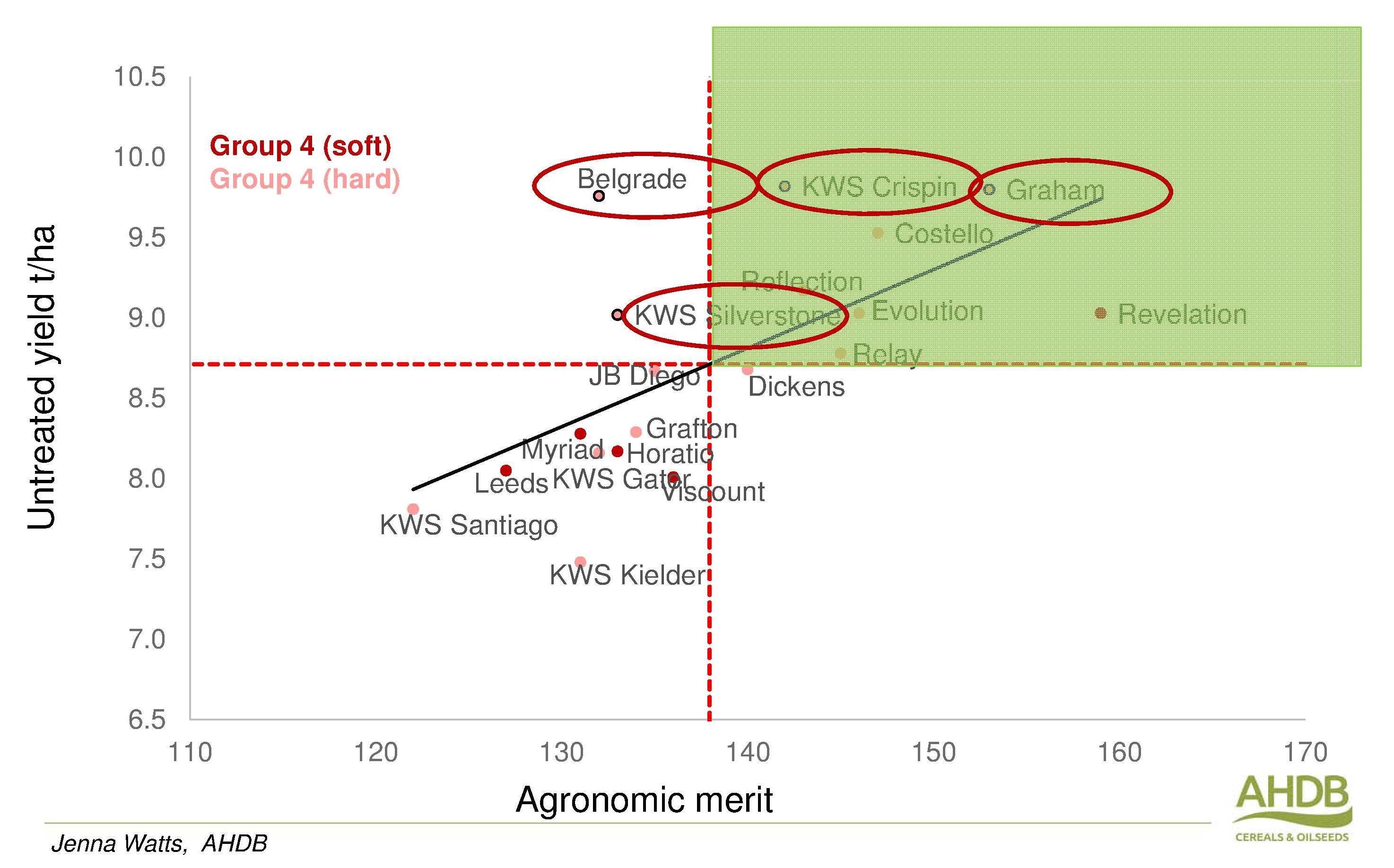
Relative risk of group varieties
“For established varieties, there’s more seasonal data and more grower experience which means any disease weaknesses can be well managed with fungicides. For example, looking at Group 4 wheat varieties, familiar names like JB Diego, Leeds and KWS Santiago all appear in the lower left quadrant (high risk – low untreated yields, low agronomic merit) on a relative risk assessment but many growers are comfortable with these varieties because they know how to grow them well,” he explains.
“For newer varieties, such as Graham, there’s less seasonal data and limited grower experience. In a quality wheat market situation, then there’d be the added factor of less market confidence to consider as well.
“It’s important for varietal choice to be based on what the end user is demanding, which may limit early uptake on new varieties. But for feed growers in particular, relative risk should help give them the confidence to put a new variety in the ground earlier in its evolution, rather than wait until it’s a tried and tested variety,” he says. Learning to grow a variety and assess whether if it’s a good fit for the conditions on the farm it’s growing in won’t change, he adds.
Further into the future, a relative risk analysis of oilseed rape may be available to growers to aid their variety selection. “Untreated yield hasn’t been considered as part of the selection criteria for the OSR RL for several years but we’re bringing it back so we can look at the combined agronomic and untreated yield characteristics of OSR varieties in a similar way to wheat varieties, removing some of the uncertainty.”
The updated variety selection tool will sit on AHDB Cereals & Oilseeds Monitoring pages – cereals.ahdb.org.uk/monitoring
Relative risk a potentially useful tool
Will Hamilton sits as chair of the RL wheat committee and also farms 780ha on the Berwickshire coast in south-east Scotland. As such, he’s a grower with an insider’s view on the benefits of relative risk when it comes to making variety choices.
He describes himself as a grower who likes to try new varieties and with 30% of his farmed area in winter wheat, he has plenty of opportunity to try out a few each year. “I usually have a core acreage in an established variety – this year it’s Leeds – and then have a look-see at a couple of varieties that have been about a couple of years and some newcomers. For 2016, the remaining acreage is split between Skyfall, Dickens, Reflection, Revelation and RGT Conversion,” he says.
Asked how he selects varieties on his own farm, Will Hamilton says he looks at three attributes and like most other growers, number one on the list is markets. “In my area the biggest market opportunity is grain distilling. Historically this has been for soft wheats but recently the market has opened up to include hard wheats, which is why I’m growing Skyfall, Reflection and Dickens and there are also promising-looking Group 4 soft wheat RL candidate varieties in the pipeline,” he explains.
Second on the list is yield, still a very important consideration but perhaps not as all important as it once was, believes Will Hamilton. “Yield isn’t the be all and end all anymore, it’s something I look at but I also want to know about other traits, like disease resistance, standing power, earliness of ripening and grain quality. I never used to look at untreated yields but I do now,” he says.
So it’ll come as no surprise that the third consideration in his own selection criteria is agronomic characteristics. “Septoria is becoming a very important disease and will be the hardest to control in the future, with the decline in azole activity and potential SDHI resistance. On top of that, the impact of future legislation means that all in all, I want to grow varieties with good resilience,” he explains.
Reflection is a variety that’s fallen foul of the rapidly changing yellow rust population and is unlikely to maintain its low relative risk position after this season, says Will Hamilton, highlighting the necessity to monitor the effect of changing conditions.
But on his farm, the Reflection has fared much better than in some areas, being later drilled and unaffected by yellow rust. “Reflection is high yielding with better grain quality and earlier ripening so it’s disappointing it’s broken down so quickly.”
With his RL hat on, Will Hamilton explains that the advent of relative risk hasn’t changed the way varieties come through the RL system because the committee is already much more focused on agronomic traits than in the past.
“Disease resistance already features prominently in RL candidate discussions. What relative risk has provided us with is a more understandable form of the data which already exists and it’s used as a check in the RL recommendation process.”
In his opinion, relative risk data has the potential to provide growers with a really useful tool to help management decision making, but it needs to be right. “Relative risk crystallises information into a very easy to understand form and growers were showing a lot of interest in it at the AHDB Risk and Resilience Workshops,” he notes.
“But its strength is in the quality of the data and making sure that the agronomic characteristics are weighted correctly,” he cautions, adding that relative risk has a lot of potential and it’s a tool AHDB are really keen to keep developing.

